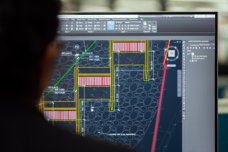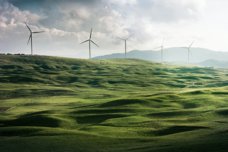Introduction
The energy transition that we are currently facing is by no means the first of its kind. It all began when humans mastered fire. The next energy transition came about with the domestication of animals that could transport things and do work that humans used to do. Then we went on to use combustion engines (1705) and nuclear energy (1945). An important thing about these previous energy transitions is that each one provided humankind with more energy than before. That may not be true for this latest one.
The present energy transition is, in essence, a decarbonization. We need to make sure that we are not emitting CO₂, so we need to transition from CO₂-emitting energy sources to others. We have to end the usage of fossil fuels and, in the process, limit climate change.
The Dutch government's 2016 Energy Report Transition to sustainable energy defines four functions of energy:
• Space heating – energy used for heating houses and buildings
• Industrial process heat – energy used for, e.g., brewing beer, processing food, heating greenhouses, drying fruits and vegetables. etc.
• Transport
• Power and light
The above makes clear that the energy transition extends beyond mere electricity.
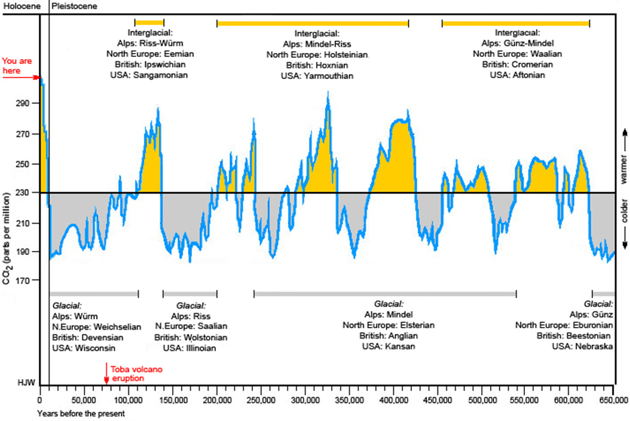
Figure 1: Parts per million of CO₂ in the atmosphere over the past 500.000 years. The present is on the left side of the figure. Source: van der Meer, F. D., van Westen, C. J., & Gorum, T. (2014). The role of fault mechanisms and tectonics on the occurrence of coseismic landslides: landslides and hazard risk assessment: remote sensing and GIS approach: powerpoint.
Figure 1 is a reconstruction of the past 500,000 years in terms of the actual parts per million (ppm) of CO₂ in the atmosphere. The yellow segments represent times when there were large amounts of CO₂ in the atmosphere. Seen in this light the current situation is not unique. Similar periods occurred before, in the interglacial periods, when the climate was a lot warmer than what we are used to. Right now we are also in an interglacial.
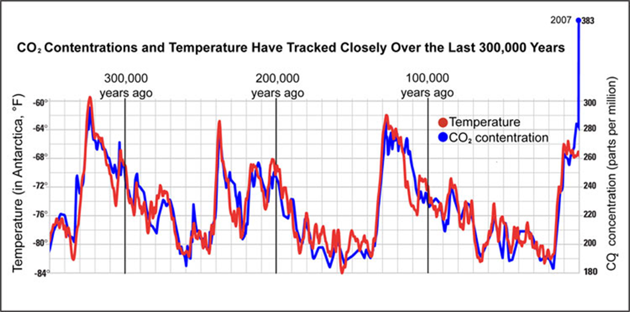
Figure 2: CO2 concentrations and temperature over the years. The present is now on the right side of the graph. Source: Adapted from the Marian Koshland Science Museum of the National Academy of Sciences (CC BY 4.0 Deed | Attribution 4.0 International | Creative Commons)
Figure 2 shows that there is a clear link between temperature and CO₂. Over time the two curves follow each other relatively closely. In the last 100 years, however, CO₂ has peaked at an unprecedented rate. result, the link between CO₂ and temperature has been lost. But this is only temporary because the temperature will follow suit. Its lagging behind can be explained by the fact that the CO₂ concentration has been rising extremely rapidly by mechanisms other than natural causes. This in itself makes the current energy transition unavoidable.
In addition to this, see also the three reasons that David MacKay formulated for our needing the energy transition, in his online book Renewable energy without the hot air:
• Fossil fuels will run out soon enough.
• We do not like to depend on other nations for energy supply.
• The climate is adversely affected.
At the UN Climate Change Conference (COP21) in Paris, 2015, world leaders agreed that global warming should be kept below 2 degrees Celsius. Six years later in Glasgow (COP26), the agreement was amended to 1.5 degrees, which indicates that we have learned that global warming should be kept lower to avoid massive problems. Based on these international agreements, nations make local agreements, as one solution obviously does not fit all.
From 1992 to 2018, the global usage of photovoltaic solar panels grew exponentially. Over the same period, the use of coal stagnated – even slightly decreasing. Oil and gas were still going up, while nuclear remained relatively stable. In a sense, the energy transition has already started, but much remains to be done.
Figure 3 shows what the European Union and its members had achieved by 2021 in terms of using renewable energy sources. Some countries had been doing very well, but many – including the Netherlands – were clearly going to have a hard time meeting the target for 2030. By now, of course, numbers have changed a bit, but there is also less time left. In the Netherlands, progress had been so slow that the Dutch Urgenda Foundation even took the government to court demanding more efforts to fight climate change (Urgenda is an NGO that aims for a fast transition towards a sustainable society, with a focus on the transition towards a circular economy using only renewable energy). The case was won, which goes to show that NGOs can now take governments to court and get them to accelerate their efforts.
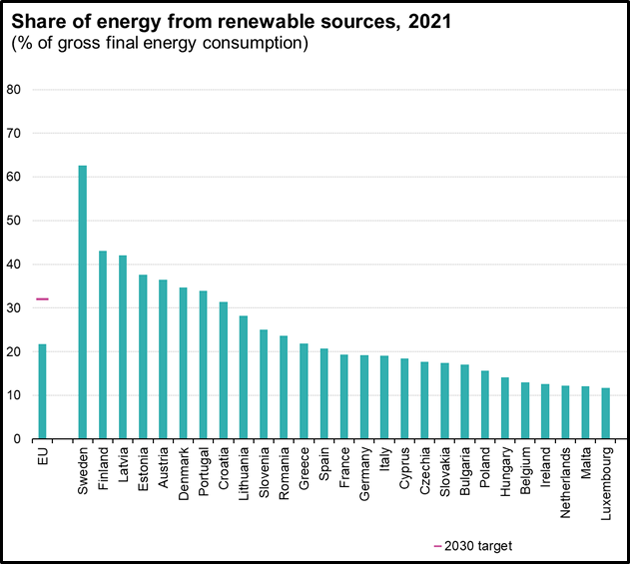
Figure 3: Share of energy from renewable sources, 2021. Source: ec.europa.eu/eurostat
In figure 4 the usage of energy per person in certain parts of the world has been plotted against the number of people that live there. It is clear that North America and Europe have relatively low population sizes and high energy consumption levels as opposed to, for example, Asia. In other words, energy usage is unequally distributed.
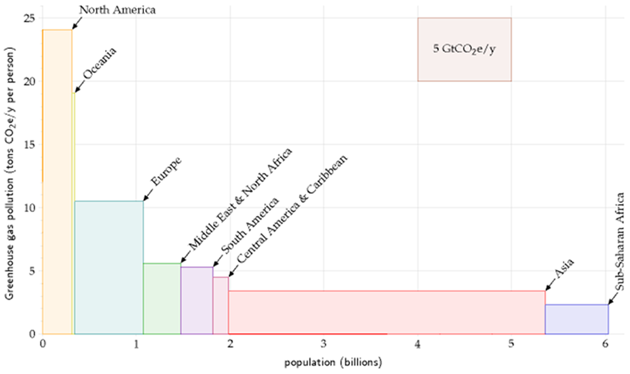
Figure 4: Greenhouse gas pollution per person aggregated over regions. Source: MacKay 2008 p. 12
In chapter 18 of his online book David MacKay demonstrates, by way of example, that the UK will never be able to produce the amount of energy required for the current consumption levels using only renewable sources. Especially in North America and Europe, the energy transition will take more than just changing the sources and investing in moving from oil and gas to windmills and solar. Engineering solutions will not be sufficient as an answer to the issues that await. Behavioural change will be required as well. Humankind started with mere muscle power and then went on to fire, animals, combustion engines and nuclear power. With every transition more energy became available. The transition that we are now facing is different, in that we will have less energy available than before.
Examples of engineering solutions
Of course, engineering will have a major part to play. Here are some examples, categorized by the four functions of energy as defined in the 2016 Dutch Energy Report Transition to sustainable energy mentioned earlier.
Power and light. Not every area has the same potential for all types of electricity production. It is a matter of finding the right mix for a particular country. For instance, onshore and offshore wind farms can achieve substantial electricity production in certain coastal areas. Figure 5 shows the areas worldwide that are most suitable for such wind farms. The darker the purple colours, the more suitable the location. For example, the North Sea is very suitable for offshore wind farms, and it is also close to the densely populated centres of Europe. Locations in the tropics, however, are less suitable because winds are not as persistent and as useful. As to onshore locations, Ireland, Tierra del Fuego and some of the elevated areas on the west coast of the Sahara Desert are examples of very suitable areas, as well as some of the more mountainous areas. But large areas have no or very low potential for on-land wind farms.
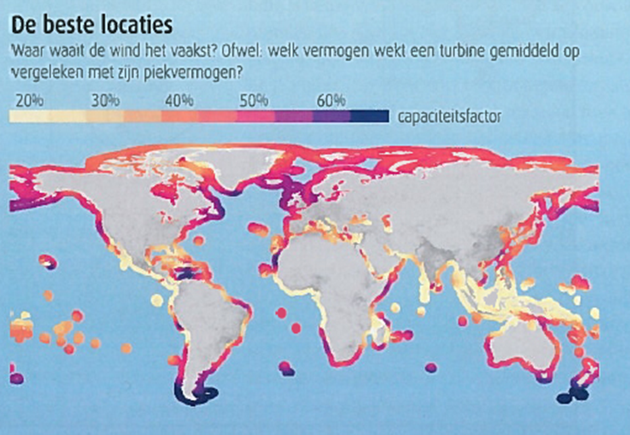
Figure 5: Coastal areas most suitable for wind farms. Source: IEA 2019a
A similar world map can be made for areas with high degrees of solar irradiance that are most suitable for producing electricity using massive amounts of solar panels. Another example of an energy source that works very well in some areas is electricity from volcanic geothermal systems. These are areas that have big intrusions at a shallow depth, with hot circulating fluids in the subsurface which can be used for electricity production in a power plant. Obviously, this type of energy production is only feasible in areas with volcanism, so it is spatially limited.
Space heating. In the Netherlands right now, most homes are heated by individual gas heaters that distribute hot water to radiators. An innovative concept here is to provide homes with hot water instead of gas – which would make gas no longer a necessity for producing heat. This system is called district heating. For instance, in the Dutch region of Twente there is an installation where heat is generated by burning waste. The heat is then distributed in the form of hot water to homes and customers through special pipeline networks.
Industrial process heart. The Netherlands is not in a volcanic area, so producing electricity from geothermal heat is not an option, because there are no sufficiently high temperatures close to the surface. However, using geothermal heat (at temperatures of 60 to 90 degrees Celsius) for heating buildings is a possibility. This principle requires doublets with one drill hole to inject cold water down and another one to bring hot water back up. The idea is to circulate the same water into the subsurface. When it is used on top, it cools down, when it is pumped back down it heats up again. Currently there are about 25 of these systems in the Netherlands, 20 of which are fully operational right now. The Master Plan Geothermal Energy in the Netherlands calls for 700 doublets by 2050, but there has been stagnation for years, mainly because of the high investment risks these large doublets entail. A possible alternative could be to use so-called low unit cost installations. They are smaller, operate at lower temperatures and are easier to integrate into the urban landscape. It goes without saying that many of these installations would be required to achieve the output doublets would.
Transport. Whilst the world’s normal street cars are moving towards electric, hydrogen still has an important part to play as well – especially when it is green. In the Netherlands, green hydrogen can be produced by using wind turbines at sea, for example. One of the benefits of green hydrogen is that processes can stay similar to those used for natural gas.
Vehicles could also be run on biofuel, but that would require large-scale production. MacKay estimated that if the UK wanted to run their transport on biofuels that would require an eight-kilometre-wide strip along each road just to produce the fuel. That is certainly not an option in the Netherlands.
Another engineering solution that is actively thought about is to not avoid CO₂ but capture it and pump it into reservoirs. This method is known as carbon capture and storage (CCS). The biggest problem is that nobody wants such storage facilities in their vicinity because of the risk of CO₂ being released. Consequently, possibilities for offshore storage are currently being investigated.
How subsidies can have adverse effects
In 2016, the Dutch Energy Report Transition to sustainable energy named biomass a low CO₂ energy source which is likely to be part of the solution. At the time. the development of biomass power plants was supported with large subsidies. By 2021, things had changed drastically. According to the Dutch government coalition agreement the usage of woody biomass for energy purposes should be reduced as fast as possible. The reason for this dramatic switch was that the subsidies had led to unforeseen consequences. Clever entrepreneurs were shipping perfectly fine trees from other countries to the Netherlands to burn them here as an electricity source.
This subsidy issue also occurs in the case of solar panels on roofs in the Netherlands. Subsidies make installing solar panels attractive, all the more so because people can give the electricity back to the power company for temporary “storage” and take it back from them later without any extra costs. They store it free of charge. For users, that is an ideal situation, because they can produce a lot of energy in the summer and use it in the winter without having to pay for it. This is the very reason that the Dutch market for home batteries had been non-existent so far. Also, there is a lot of power going back and forth, which means that the power companies need to put in bigger cables to accommodate the massive production during the summer.
To summarise, subsidies can influence how technology develops and what starts out as a good idea may later turn out to hamper progress.
The role of nuclear energy
Nuclear energy always comes with two issues: how to use it safely and what to do with the radioactive waste at the end of the process. Disastrous events at Chernobyl, 1986, and Fukushima, 2011, certainly helped to polarize the discussion. In response to the Fukushima disaster, and under pressure from the public, Germany entirely closed down its nuclear power plants.
In the Dutch Energy Report Transition to sustainable energy of 2016, nuclear technology was not ruled out - as long as it is safe. In the 2021 coalition agreement, the government announced that it would keep the existing nuclear plants open longer and even add two new ones. Dr. Hecker agrees that nuclear is probably part of the solution.
A glimpse at the remaining challenges
Finding the right place for geothermal energy. The best locations for hydro, solar and wind are easier to predict than subsurface resources. As for geothermal energy, it is very hard to say where the best places for drilling are, as there is too little information about underground porosity, permeability and temperature distribution. As a result, geothermal exploration is always a high-risk venture. As figure 6 shows, the project risk is extremely high throughout the pre-survey exploration test drilling. This means a lot of work needs to be done before trying to pinpoint where to drill, because drilling costs about €1,000,000 per kilometre depth and is typically done down to two to three kilometres. Drilling two times means spending € 6 million, so it is important to get it right. Extra efforts in early exploration can reduce (but not eliminate) the risk for a project. In any case, integration of all available sources of geodata information is crucial.
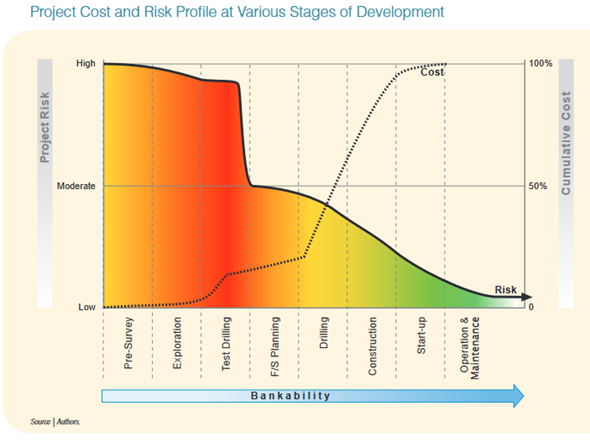
Figure 6: Project Cost and Risk Profile at Various Stages of Development. Source: ESMAP Handbook 2012
Social acceptance of locations. NIMBY (not in my backyard) is a serious obstacle when it comes to implementing engineering solutions. Everybody thinks CO₂ storage is a good idea, but nobody wants to be near such an underground reservoir. One alternative location for the storage of CO₂ now being looked at is old gas reservoirs off the coast. Windmills also face acceptance issues, as nobody wants them in their backyard either. Another example is the dire situation caused by massive gas extraction from a field in the Dutch province of Groningen, which eventually led to subsidence (caving in or sinking of land), damage to houses and earthquakes. Because of all this, subsurface activity is now even more strongly opposed to in the Netherlands, and it is very difficult to get anything organized.
Trade-offs. The implementation of engineering solutions always comes with trade-offs that deserve careful consideration. A few examples:
• Wind turbines inevitably kill birds from time to time. The question is, how many birds are acceptable? Is one species more acceptable than another?
• As a result of subsidies, many grassy fields across the Netherlands are now covered with solar panels, which many consider visual pollution.
• Is water primarily meant for aquatic life or for floating solar parks? How are we changing aquatic life if there is no sunlight coming through anymore?
• Hydropower dams can flood villages and rare species habitats. Because of this risk, in Switzerland it is very hard these days to get new dams built.
Sufficient access to raw materials. Dr. Hecker considers new mining an indispensable part of the energy transition. Rare earth elements (REE) are needed for magnets in electric vehicles, engines, turbines, power stations. Lithium and cobalt are needed for high density batteries, and copper and aluminium for electricity. Some of these materials come from either single supply countries, conflict countries or countries where child labour is still commonplace. The challenge will be to get the materials the best way possible, from the best places with the best circumstances for the people doing the work, and with the highest safety standards for people and nature.
The above topic was also covered in a TED talk by ITC’s Arjan Dykstra.
How can Remote Sensing and GIS help us here?
Geothermal exploration. Remote sensing techniques can help to pinpoint suitable locations for geothermal energy. For instance, measuring temperatures of geothermal anomalies at the surface allows for conclusions to be drawn about the subsurface, such as the probability of hot springs and fumaroles. Subsequently, different remote sensing techniques can be applied to actually find those hot springs and fumaroles. For example, kaolinite clay can be mapped with hyperspectral remote sensing, and fumaroles can be mapped with thermal infrared remote sensing and LIDAR DEMs.
Fumarole monitoring. Dr. Hecker is involved in a project called GeoHot that is being actively pursued in three countries. In this project, thermal [CH1] remote sensing images serve to gather information about fumaroles on the ground, e.g., where in the world they can be found. Some areas are known but there are other areas that have so far remained hidden and are currently being investigated as a starting point for detailed ground investigation.
Greenhouse gas emission monitoring. Private company GHGSat has commercial satellites that monitor different greenhouse gases. Data gathered can be used for mapping. For example, a map can be created that not only shows that there is methane in the atmosphere but also directly pinpoints where it is being released. This is also a good way of monitoring the amounts of methane being released as a result of oil and gas installation operations.
Air quality with Sentinel 5P . The TROPOMI instrument on Sentinel 5P is used to map hotspots of tropospheric nitrous oxide. These satellites make it possible to monitor air quality and determine where some of these gases are being released. Nitrous oxide is not typically a greenhouse gas in itself, but it is involved in the creation of tropospheric ozone which, of course, is a greenhouse gas.
Proximal sensing core drilling. ITC’s GeoScience Lab features a hyperspectral camera which can record hyperspectral images of samples. This camera is now being used to reinvestigate existing Dutch drill cores from oil or gas exploration in order to find suitable locations for CO₂ storage or geothermal energy extraction.
Participatory spatial planning with geoinformation. In central locations such as the ITC Design and Interaction Space for Co-creating (DISC), stakeholders can look at geodata together and try to decide which consequences certain actions will have. For instance, what will happen if we place a windmill here? Will we have enough energy or will we need more windmills? Gathering stakeholder input this way can also serve to leverage decision making on the spot as well as increase social acceptance.
Conclusion
Not all technologies that could support the energy transition work equally well all over the world. The effectiveness of technologies such as solar, wind and geothermal greatly varies per area. Dr. Hecker is convinced that moving to renewables without changing behaviour and reducing consumption is not going to work – probably not even when nuclear power is part of the equation. Paradoxically, mining for critical raw materials is part of a clean energy solution, with the possible addition of nuclear power. Dr. Hecker also stresses that not all problems have an engineering solution. In his view, the important thing is to be in contact, engage in discussion and make it a joint effort to increase social acceptance and achieve a crucial change in mindset.
